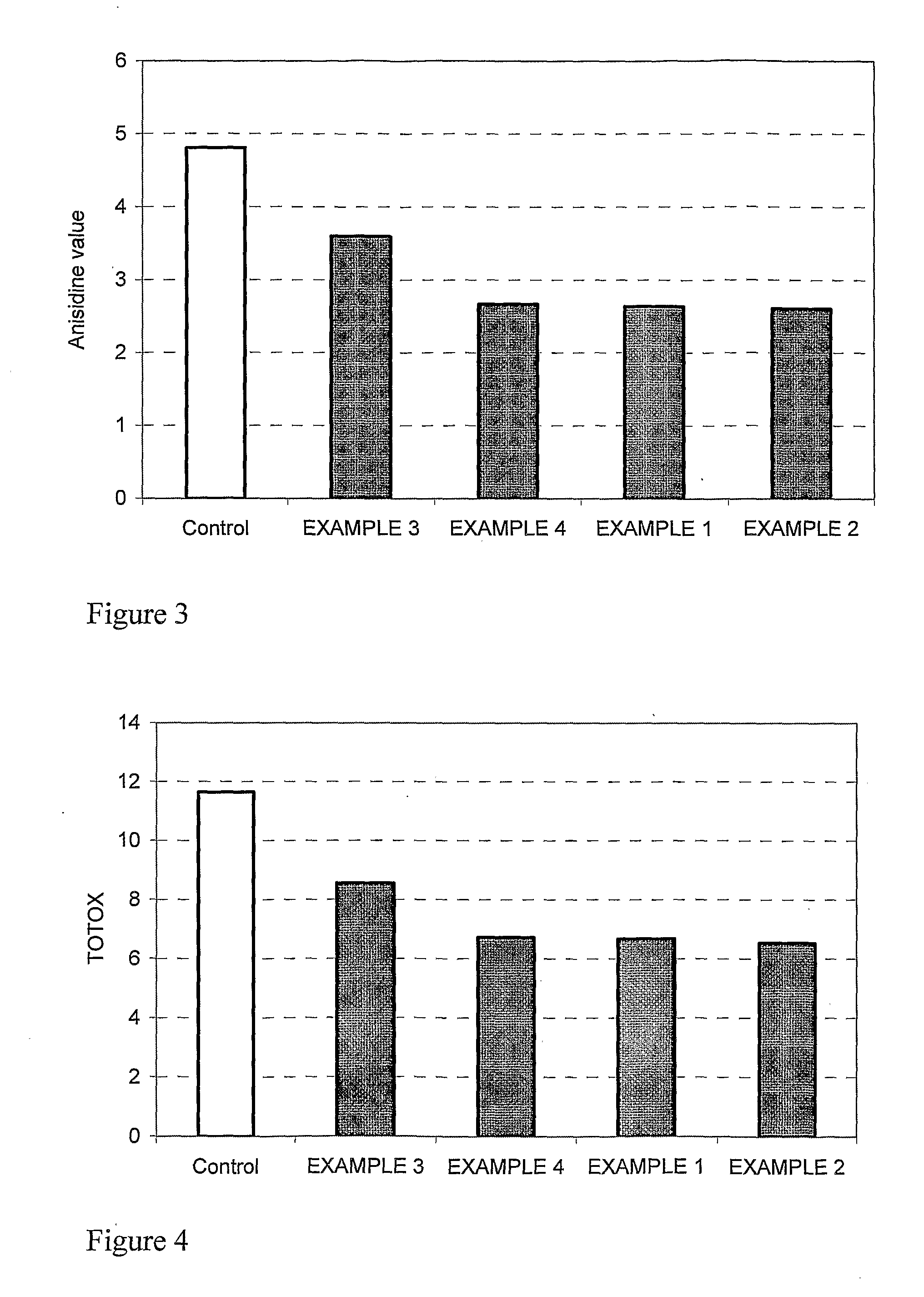Antioxidant stabilisation of nuts and seeds and of products containing the same
a technology of antioxidant stabilisation and nuts, which is applied in the field of stabilisation and protection of nuts, seeds and products containing nuts and/or seeds, and can solve the problems of nuts, nuts, seeds, sunflower seeds, seeds, etc., and products containing the same, etc., to achieve the effect of preventing spoilag
- Summary
- Abstract
- Description
- Claims
- Application Information
AI Technical Summary
Benefits of technology
Problems solved by technology
Method used
Image
Examples
example 1
[0044]50 mL 96% (v / v) ethanol were added to 1 g of rosemary extract containing 20% by weight of carnosic acid, 5% by weight of carnosol and 3% by weight of methyl-carnosol, and the mixture was stirred for 15 minutes at room temperature.
[0045]Walnuts kernels, removed from their shells, were sprinkled with a solution of rosemary extract in ethanol so that the concentration of rosemary extract in comparison to the fat content of the walnuts was 0.005% (0.05 g / kg), 0.02% (0.2 g / kg) and 0.1% (1 g / kg). The kernels were then dried in a dryer for two hours at a temperature of 60° C. The kernels were kept at room temperature for two months. When the storage period was over, fat was isolated from the walnut kernels by extraction, and their oxidation status was measured by a Rancimat test. The peroxide and anisidine values, as well as the oxidation value (TOTOX) of the isolated fat were calculated. A control sample was prepared by the same procedure, without the addition of an antioxidant.
[004...
example 2
[0048]50 ml of 96% (v / v) ethanol were added to 1 g of rosemary extract containing 20% by weight of carnosic acid, 5% by weight of carnosol and 3% by weight of methyl-carnosol and the mixture was stirred for 15 minutes at room temperature.
[0049]Walnuts kernels, removed from their shells, were sprinkled with a solution of rosemary extract in ethanol so that the concentration of rosemary extract in comparison to the fat content of the walnuts was 0.005% (0.05 g / kg), 0.02% (0.2 g / kg) and 0.1% (1 g / kg). The kernels were then dried at room temperature (T=23° C.). The kernels were kept at room temperature for two months. When the storage period was over, fat was isolated from the walnut kernels by extraction, and their oxidation status was measured by a Rancimat test. The peroxide and anisidine values as well as the oxidation value (TOTOX) of the isolated fat was calculated. A control sample was prepared by the same procedure, without addition of an antioxidant.
[0050]The sample with the ad...
example 3
[0052]A diluted rosemary extract containing 10% of rosemary extract (20% by weight of carnosic acid, 5% by weight of carnosol and 3% by weight of methyl-carnosol), 5% of emulsifier (DATEM) and 85% of maltodextrin was prepared.
[0053]Walnuts kernels, removed from their shells, were powdered by the diluted rosemary extract so that the concentration of rosemary extract in comparison to the fat content of the walnuts was 0.005% (0.05 g / kg), 0.02% (0.2 g / kg) and 0.1% (1 g / kg). The walnut kernels were then kept at room temperature for two months. When the storage period was over, fat was isolated from the walnut kernels by extraction, and their oxidation status was measured by a Rancimat test. The peroxide and anisidine values as well as the oxidation value (TOTOX) of the isolated fat was calculated. A control sample was prepared by the same procedure, without addition of an antioxidant.
[0054]The sample with the added rosemary extract in a concentration of 0.02% (0.2 g / kg) had by 1.5-times...
PUM
 Login to View More
Login to View More Abstract
Description
Claims
Application Information
 Login to View More
Login to View More - R&D
- Intellectual Property
- Life Sciences
- Materials
- Tech Scout
- Unparalleled Data Quality
- Higher Quality Content
- 60% Fewer Hallucinations
Browse by: Latest US Patents, China's latest patents, Technical Efficacy Thesaurus, Application Domain, Technology Topic, Popular Technical Reports.
© 2025 PatSnap. All rights reserved.Legal|Privacy policy|Modern Slavery Act Transparency Statement|Sitemap|About US| Contact US: help@patsnap.com


